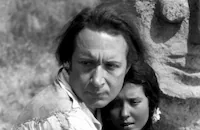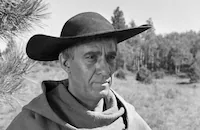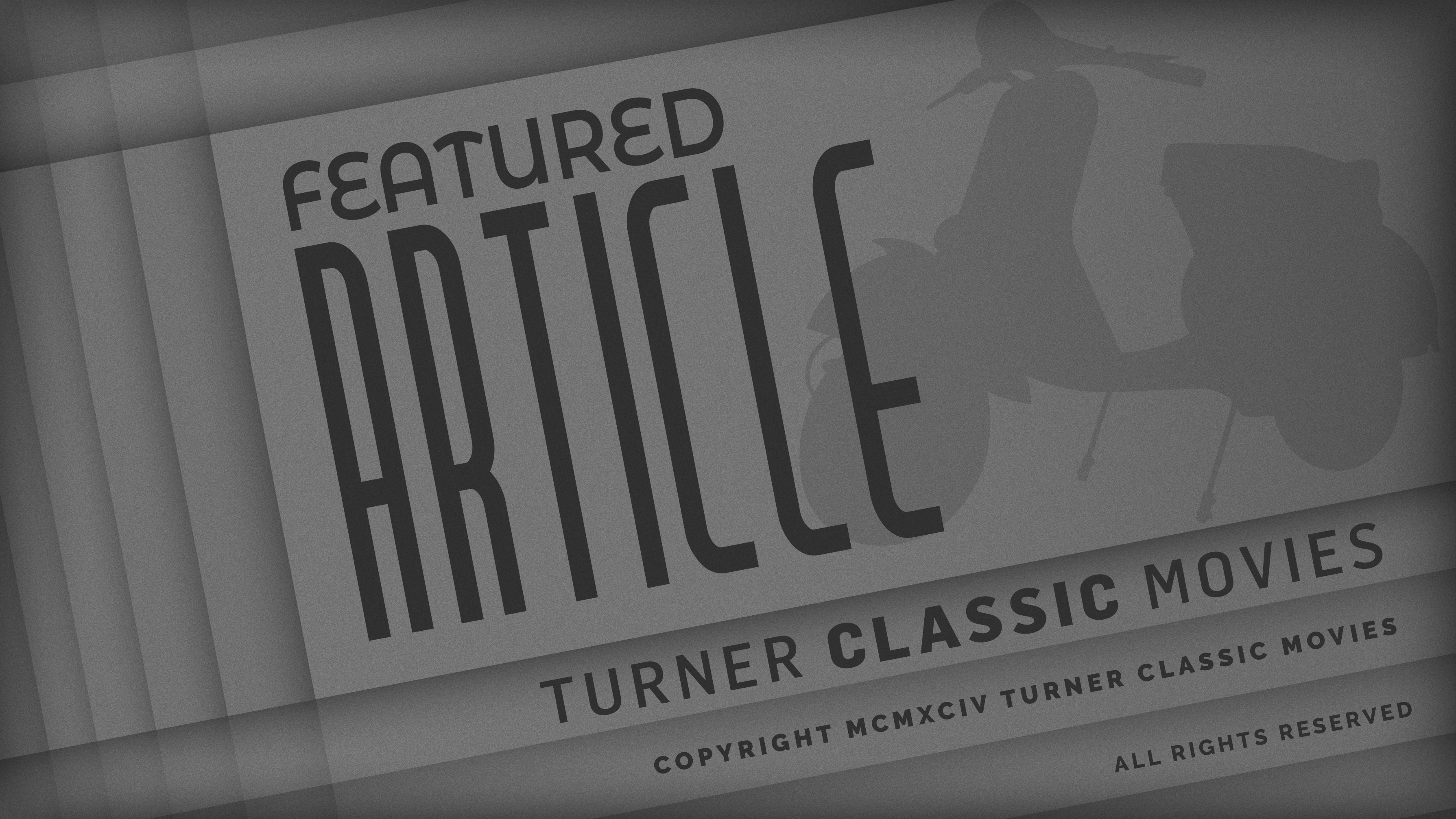Song of the Gringo

Brief Synopsis
Cast & Crew
John Mccarthy Jr.
Tex Ritter
Joan Woodbury
Fuzzy Knight
Monte Blue
Warner Richmond
Film Details
Technical Specs

Synopsis
Lawman Tex goes undercover as an outlaw by holding up miners Robert Henderson and Norman Conklin as they turn in gold from their mine. During a storm, Tex is chased by the sheriff and his deputies to the hacienda of Don Estaban Valle, where Tex hides. Hoping to capitalize on Tex's talents as an outlaw by hiring him, Señor Evans, Don Estaban's business partner, convinces the sheriff to give up his search for Tex in the house. When Tex emerges from his hiding place, he finds himself in the bedroom of Lolita, Don Estaban's daughter, and she nurses his wound and falls in love with him. Evans then recruits Tex to help him steal the profitable Henderson-Conklin mine. Evans and Don Estaban have recently financed a string of mine owners who have run into trouble. Mysteriously, all those who have accepted Evans' help have been killed, after which their property has been seized by Evans and Don Estaban. Unaware that Evans has been hiring men to kill the miners, Don Estaban has innocently profitted. Soon Evans becomes jealous of Tex's favor with Lolita, whom Evans desires, while Cherokee begins to suspect Tex's loyalty to Evans. Forcing Tex to prove himself, Evans instructs him to dynamite the Henderson-Conklin mine, then orders Tex to kill the miners. While Cherokee watches nearby, Tex successfully fakes the murders, making it look as if Henderson and Conklin shot each other, then orders them to go into hiding. After the newspapers report Henderson and Conklin's death as part of a growing list of tragedies associated with Don Estaban, he vows to extricate himself from Evans' crime ring. At Lolita's birthday fiesta, to which the sheriff has been invited, Lolita, alone with Tex, warns him to leave before he is killed. Don Estaban then catches the couple embracing and, denouncing Tex for bringing shame to his house, orders him to leave. During their argument, Don Estaban is shot, and Tex is blamed. Following Evans' orders, the Estaban maid identifies Tex as the outlaw whom the sheriff chased the night of the storm, and Tex is arrested for the miners' murders and stands trial. Tex proves his innocence by arranging for Henderson and Conklin to enter the courtroom. In a panic, Evans shoots Tex in the arm, and himself is shot by the sheriff and Tex. Later Tex returns to Lolita's room with a wounded arm, and she tells him her father, now recovered, has given them permission to marry.

Director
John Mccarthy Jr.
Cast

Tex Ritter

Joan Woodbury

Fuzzy Knight

Monte Blue
Warner Richmond
Al Jennings

Martín Garralaga
William Desmond
Forrest Taylor
Robert Fiske
Rosa Rey
Jose Pacheco And His Continental Orchestra
Richard T. Adams
White Flash, The Horse
Crew
Edward L. Alperson
Frederick Bains
Charles Clague
Robert Emmett
Robert Emmett
Edward F. Finney
Al Jennings
John Mccarthy Jr.
Harry Miller
Jose Pacheco
Lindsley Parsons
Lindsley Parsons
Gus Peterson
Harry Revel
Tex Ritter
Cliff Ruberg
Frank Sanucci
Robert Tansey
Joan Woodbury

Videos
Movie Clip


Film Details
Technical Specs

Articles
Song of the Gringo -
The coming of sound brought a new sensation to the movies: the "singing cowboy," a genre that featured upright, clean-cut cowboys who sang songs of life on the range between dramatic scenes. Ken Maynard popularized the genre and Gene Autry, a successful recording artist before he appeared in onscreen, became a star in a series of westerns produced by the newly-created Republic Pictures. Grand National Pictures, a short-lived producer of low-budget movies, decided to create their own singing cowboy and producer Edward Finney found him in New York City. After a screen test, Finney signed Ritter to a personal contract and put together his debut feature.
Ritter moved to Los Angeles in late 1936, and had barely settled into his new Hollywood apartment when he was handed the Song of the Gringo script, whisked off to wardrobe, and sent to the recording studio to pre-record his songs. He crooned four of the seven songs featured in the film, including "Rye Whiskey," which he originally recorded a few years before, and "My Sweet Chiquita," which he composed for the picture. He received a real Hollywood welcome on his first day of shooting on location at the Monogram Ranch, where he was promptly bucked off his horse in front of cast and crew in his very first shot. Co-star Glenn Strange, who played an uncredited henchman, wasn't sure if it was the result of a practical joke or simply a mishap, but he noted that Ritter took it with good humor: "He merely sat there until the laughter died down then said, 'Oh well. That's 'bout what I expected'." His baptism complete, he climbed back in the saddle.
Finney wanted to give his neophyte leading man as much support as Grand National could afford and surrounded him with veterans. Director John McCarthy, who had made dozens of westerns in the silent and early sound eras, also developed the script, a simple story that sent stalwart lawman Tex (he used his own moniker in most of his leading man roles) undercover to get evidence against a gang murdering mine owners and taking their claims. Joan Woodbury, a dancer and former bit player recently promoted to featured roles, is the love interest Lolita, daughter of a Mexican-American rancher. Character actor Fuzzy Knight provides comic relief and former silent movie stars Money Blue and William Desmond stand in as the authority figures. Al Jennings, who plays the judge, arrived with the most interesting credentials. Before he came to Hollywood, he was a cowboy outlaw who robbed banks and trains, finally going straight after serving time in prison. According to Ritter biographer Johnny Bond, Jennings taught Ritter how to handle his six-guns for maximum visual effect on screen.
Song of the Gringo was shot on a breakneck five day schedule and released to theaters in November, 1936, with Ritter promoting the release with a series of personal appearances before returning for his next film, Headin' for the Rio Grande (1936). Grand National tried out a number of singing cowboys but Ritter, a natural for the genre., was their only success. His twang was authentic and he grew up riding horses in Texas, and his years acting and singing on the radio and the stage was better preparation than many other performers who were thrust into the role of singing cowboy. He was stockier than most romantic leads but he had a baby face, a good voice, and a solid knowledge of American folk music and cowboy songs. And while he never found the big screen stardom that Autry and Roy Rogers earned, he had a solid career in the movies as one of the definitive singing cowboys of the short-lived era. He had even more success with his recording career, which took off in the 1940s when he signed with Capitol Records and released a string of chart-topping hits. He sang the Academy Award-winning theme song to High Noon ("Do Not Forsake Me Oh My Darling") and continued recording through the 1970s. And to later generations, he's best known as the father of TV star John Ritter.
Sources:
The Tex Ritter Story, Johnny Bond. Chappell & Co., 1976.
Riders of the Range: The Sagebrush Heroes of the Sound Screen, Kalton C. Lahue. A.S. Barnes and Co., 1973.
Singing on he Saddle: The History of the Singing Cowboy, Douglas B. Green. Vanderbilt University Press, 2002.
AFI Catalog of Feature Films
IMDb
By Sean Axmaker

Song of the Gringo -
Quotes
Trivia
Notes
This film marked Tex Ritter's film debut and was, according to exploitation materials, the first in a series of "romantic action western musicals" produced by Edward F. Finney for Grand National starring Ritter and his horse "White Flash." Although the onscreen credits list Frank Sanucci and Harry Revel as two of the film's songwriters, press material found in copyright records does not credit them with specific song titles. Modern sources list the following additional cast members: Glenn Strange, Budd Buster, Murdock McQuarrie, Ethan Laidlaw, Charles "Slim" Whittaker, Edward Cassidy, Earl Dwire, Jack Kirk and Bob Burns.














